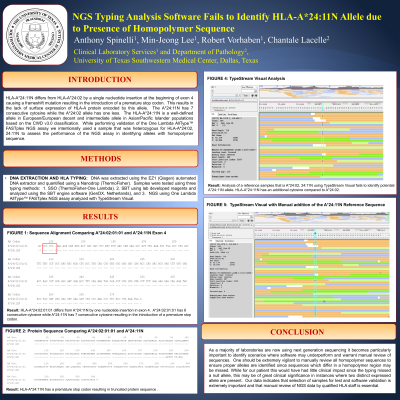Back

NGS Typing Analysis Software Fails to Identify HLA-A*24:11N Allele due to Presence of Homopolymer Sequence
(P713) NGS typing analysis software fails to identify HLA-A*24
Location: Platinum Ballroom

Poster Presenter(s)
Body: HLA-A*24:11N differs from HLA-A*24:02 by a single nucleotide insertion at the beginning of exon 4 causing a frameshift mutation resulting in the introduction of a premature stop codon. This results in the lack of surface expression of HLA-A protein encoded by this allele. The A*24:11N has 7 consecutive cytosine while the A*24:02 allele has one less. The HLA-A*24:11N is a well-defined allele in European and intermediate allele in Asian/Pacific Islander populations based on the CWD v3.0 classification. While performing validation of the One Lambda AllType™ FASTplex NGS assay we intentionally used a sample that was heterozygous for HLA-A*24:02, 24:11N to assess the performance of the NGS assay. Analysis using TypeStream Visual version 3.0.0 failed to identify this sample as being heterozygous. It identified the sample as HLA-A*24:02 homozygous and did not flag in the analysis that a possible variant may be present. It gave only 1 consensus sequence despite greater than 38% of the sequences showing an extra cytosine in exon 4. The software did, however, insert a flag to indicate a homopolymer sequence was present. Manual review of the NGS raw sequence data clearly showed that the sequence was heterozygous. Since we knew this sample had the A*24:11N allele, we were able to select from the drop-down menu of all alleles in the current HLA database loaded into TypeStream Visual and force the software to display the A*24:11N variant. But without that knowledge one would need to use a tool to query the sequence and determine if the sequence with an additional cytosine belonged to a previously identified HLA allele or is a novel allele.
Conclusion: Since most laboratories now use NGS, it becomes particularly important to identify scenarios where software may underperform and warrant manual review of sequences. One should be extremely vigilant to manually review all homopolymer sequences to ensure proper alleles are identified since sequences which differ in a homopolymer region may be missed. While for our patient this would have had little clinical impact since the typing missed a null allele, this may be of great clinical significance in instances where two distinct expressed allele are present. Our data indicates that selection of samples for test and software validation is extremely important and that manual review of NGS data by qualified HLA staff is essential.
Conclusion: Since most laboratories now use NGS, it becomes particularly important to identify scenarios where software may underperform and warrant manual review of sequences. One should be extremely vigilant to manually review all homopolymer sequences to ensure proper alleles are identified since sequences which differ in a homopolymer region may be missed. While for our patient this would have had little clinical impact since the typing missed a null allele, this may be of great clinical significance in instances where two distinct expressed allele are present. Our data indicates that selection of samples for test and software validation is extremely important and that manual review of NGS data by qualified HLA staff is essential.

